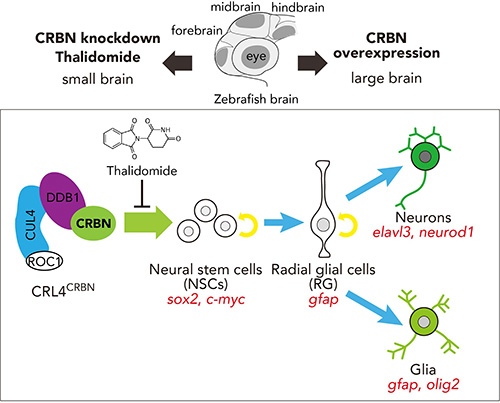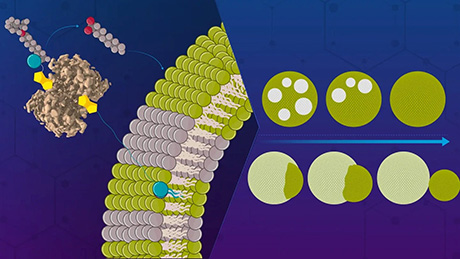Life Science and Technology News
Molecular Basis of Brain Dysfunction and Embryo Malformation Associated with Thalidomide
Scientists at the Tokyo Medical University and the Tokyo Institute of Technology identified the molecule involved in thalidomide-related dysfunctions associated with in utero brain and organ development. Their in vivo results using a zebrafish model of mammalian development showed that thalidomide binds to a protein named cereblon, a subunit of an enzyme complex responsible for the creation of neurons, thereby inhibiting normal brain development. Their results suggest this protein as a possible therapeutic target for regulating abnormal brain development.

Figure 1. Thalidomide inhibits CRBN-mediated differentiation of NSCs to promote normal brain development.
Normal CRBN activity promotes NSC proliferation and differentiation into neurons and glial cells; however, thalidomide binding to CRBN inhibits this activity, resulting in NSC death, smaller-sized brains, and dysfunctional organ, limb, and/or mental development.
In the late 1950s, thalidomide was prescribed as a treatment for afflictions ranging from anxiety to morning sickness. In the early 1960s, research indicated that the drug was the primary cause of numerous in utero birth defects, ranging from limb malformation to deafness and/or blindness.
Handa's group (Tokyo Medical University) identified that thalidomide selectively binds to a protein called cereblon (CRBN), dysfunction of which reportedly results in mental retardation and epilepsy in humans. To determine the mechanisms involved in CRBN dysfunction and its downstream effects, Handa, Yamaguchi (Tokyo Tech, School of Life Science and Technology) , and their teams studied its role in a common vertebrate animal model (zebrafish), finding that the CRBN gene encodes a protein involved in the survival and differentiation of neural stem cells (NSCs). During the embryonic stage, NSCs transform into neurons and glial cells, which are directly involved in brain development.
Their findings showed that decreased levels of available CRBN protein resulted in smaller brains in zebrafish embryos, whereas increasing its availability resulted in larger brains (Figure 1). Importantly, parallel experiments in zebrafish embryos with normal levels of CRBN revealed that treatment with thalidomide showed results similar to those observed in embryos with depleted levels of CRBN. Handa commented that these findings "suggest that CRBN selectively binds thalidomide, which alters the CRBN functions involved in promoting normal embryonic development".
Specifically, CRBN is a member of a group of molecules responsible for allowing the creation of neurons and glial cells, the latter of which are responsible for neuron proliferation and protection, from NSCs during the early stages of brain development. The authors describe a process by which inhibition of CRBN function results in the premature death of these NSCs, thereby preventing the creation of cells required for normal brain and organ development.
Importantly, the authors' findings suggest a role for the CRBN gene in regulating brain size. "This suggests potential opportunities to develop therapeutic strategies for afflictions associated with macrocephaly related to excessive brain size, such as autism spectrum disorder," said Yamaguchi. Thalidomide derivatives can be developed to control unchecked proliferation of NSCs in order to address such afflictions.
Reference
| Authors : | Hideki Ando1, Tomomi Sato1, Takumi Ito1,2, Junichi Yamamoto1, Satoshi Sakamoto4, Nobuhiro Nitta3, Tomoko Asatsuma-Okumura1, Nobuyuki Shimizu1, Ryota Mizushima1, Ichio Aoki3, Takeshi Imai5, Yuki Yamaguchi4, Arnold J Berk6, and Hiroshi Handa1,7 |
|---|---|
| Title of original paper : | Cereblon Control of Zebrafish Brain Size by Regulation of Neural Stem Cell Proliferation |
| Journal : | iScience |
| DOI : | 10.1016/j.isci.2019.04.007 |
| Affiliations : |
1Department of Nanoparticle Translational Research, Tokyo Medical University 2PRESTO 3National Institute of Radiological Sciences (NIRS) 4School of Life Science and Technology, Tokyo Institute of Technology 5National Center for Geriatrics and Gerontology (NCGG) 6Department of Microbiology, Immunology, and Molecular Genetics, and Molecular Biology Institute, University of California |
- Mechanism controlling the length of RNA made during transcription revealed: New findings could help treatments for cancer | Tokyo Tech News
- Handa Lab
- Yamaguchi Lab
- Researcher Profile | Tokyo Tech STAR Search - Hiroshi Handa
- Researcher Profile | Tokyo Tech STAR Search - Yuki Yamaguchi
- Department of Life Science and Technology, School of Life Science and Technology
- Tokyo Medical University
- Latest Research News
School of Life Science and Technology
—Unravel the Complex and Diverse Phenomena of Life—
Information on School of Life Science and Technology inaugurated in April 2016
Further Information
Professor Emeritus Hiroshi Handa
Department of Nanoparticle Translational Research, Tokyo Medical University
Email hhanda@tokyo-med.ac.jp
Tel +81-3-5323-3250
Professor Yuki Yamaguchi
School of Life Science and Technology, Tokyo Institute of Technology
Email yyamaguc@bio.titech.ac.jp
Tel +81-45-924-5798






